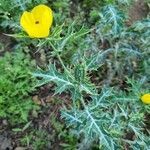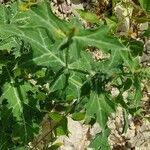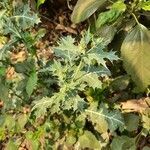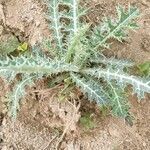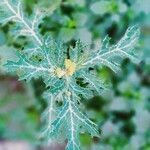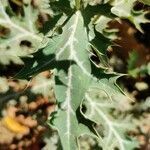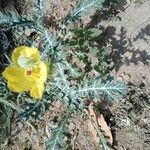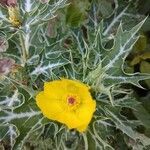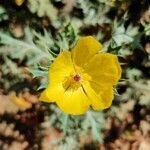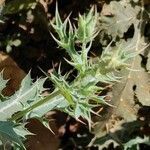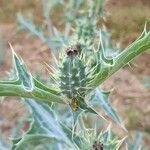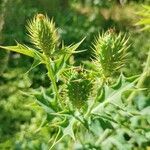Herbs erect up to about 1.2 m. high, often branching near the base.. Leaves sessile, ± sheathing (amplexicaul); prickles if present mainly on the veins of the abaxial surface ; leaves with midrib and veins irregularly outlined in greyish-white on the adaxial surface.. Flowers 2.5–4.5 cm. in diameter, subtended by 1 or 2 foliaceous bracts.. Sepals 3, caducous, covered to a greater or lesser degree with prickles.. Petals 6, yellow more rarely cream-white, glabrous.. Stamens numerous.. Stigma and style persistent, 1–3 mm. long in fruit.. Capsule oblong to broadly ellipsoid, 1.2–4.5 × 2.5 × 2.0 cm. ; valves 4–6, which split away from the vascular strands for about 1/3 of their length, exposing a cage-like frame of these vascular strands, attached apically to the persistent stigma ; outer valve-surface prickly in all tropical East African specimens seen (see Note below).. Seeds up to 2 mm. in diameter, subspherical with a small beak at one end ; testa pitted in rows radiating from the micropyle end.. Fig. 1.
Annual, thistle-like prickly, glabrous, 30-100 cm, with a firm taproot; latex bitter. Stem firm, terete, pithy, with scattered prickles. Lower leaves crowded ± in a rosette, petioled, higher ones sessile, semi-amplexicaulous, very variable in shape, sinuate-pinnatifid, glaucous, white variegate-pruinose along the main nerves, 5-22 by 3-7 cm, prickles both scattered along the margin and on the nervation of the undersurface. Flowers scentless, sessile or on a very short pedicel. Calyx-lobos green with a very acute terete horn below the apex and a few prickles. Petals obovate, bright yellow, 1¾-3 cm long. Stamens 7-12 mm; anthers ± 2.5 mm long. Ovary ovate, with long soft bristles, 8-10 mm. Stigma dark-red, 3-6-lobed. Capsule 2.5-4 cm long, with rounded ribs (later valves of the fruit) separated by pruinose grooves, on the ribs with sharp, erect prickles, dehiscing to about 1/3, valves 3-6. Seeds ± globular, ± 1.5-1.75 mm diam., fine trabecular-reticulate, black-brown, hilum pale, prominent.
Coarse, prickly annual of sunny habitats, seldom as much as 1 m. tall; stems fleshy, lightly setose-spinose, containing a yellow sap; leaves moderate, sessile, the blade mostly obovate in outline, 5-25 cm. long and up to 8 or 9 cm. wide, the upper leaves smaller, irregularly lobed or incised, the lobes spinose-dentate and rigidly mucronate at the apex, glabrous, glaucous, pinnate-veined, the lateral veins few, obscurely and laxly reticulate; inflorescence as described for the genus; sub-tending bracts consisting of 2-3 very reduced leaves from condensed nodes; flowers showy, light or dark yellow; sepals 3, roughly ovate, about 2 cm. long, rigidly mucronate-spinose apically, usually bearing a few smaller spines below, glabrous and glaucous; petals normally 6, broadly obovate, mostly 2-4 cm. long, glabrous, more or less parallel-veined. Capsule usually oblongoid, 4-to 6-valvate, prominently spinose; seeds many, from 4-6 parietal placentae, globose, reticulate, glabrous.
Annual herb, 0.3-0.9 m high; sap white to orange. Leaves sessile or clasping at base, glaucous, pinnately lobed or incised with a dentate, prickly margins, often prickly surface, often mottled over veins. Flowers: buds subglobose, length ± equal to width. Sepals 2 or 3, each lobe with conspicuous stiff apical horns; outer surface usually sparsely prickly. Petals in 2 whorls of 3, large, obovate, bright yellow. Flowering time all year, mostly Sept.-Jan. Fruit a capsule armed with needle-like prickles, opening from apex, up to 1/3 of total length, rarely almost towards base; valves separating from framework of vascular elements, with remains of persistent style and stigma still attached to vascular framework. Seeds many, orbicular, sculptured, brown-black, narrowly crested and with a short apical point.
Plants annual. Stems often branching from base, 2.5-8 dm, unarmed or sparingly prickly. Leaf blades: surfaces unarmed or sparingly prickly on veins; proximal lobed 1/2 or more distance to midrib; distal more shallowly lobed, mostly clasping. Inflorescences: buds subglobose, body 10-15 × 9-13 mm, unarmed or sparingly prickly; sepal horns terete, 5-10 mm, unarmed. Flowers 4-7 cm broad, subtended by 1-2 foliaceous bracts; petals bright yellow or rarely pale lemon yellow; stamens 30-50; filaments yellow; pistil 4-6-carpellate. Capsules oblong to broadly ellipsoid, 25-45 × 12-20 mm (including stigma and excluding prickles when present), unarmed or prickly, longest prickles 6-10 mm. Seeds 1.6-2 mm. 2 n = 28.
Buds (excluding sepal horns) subspherical or slightly longer than wide, 12–16 mm long, 9–12 mm wide. Sepals with 4–8 prickles; sepal horn 6–10 mm long. Petals narrowly to broadly obovate, 22–32 mm long, 12–22 mm wide, bright yellow. Stamens 50–100. Capsules oblong to broadly ovate-elliptic, 26–36 mm long (including stigma), 14–18 mm wide (excluding spines), 4–6-carpellate, spinose; capsular spines 14–20 per valve, straight to outwardly curved, very unequal, the largest 5–9 mm long. Seeds 1.5–1.7 mm diam.
A spreading clump forming annual herb. It grows up to 1 m high and spreads to 30-40 cm across. The leaves do not have leaf stalks. The leaves have a green and white pattern. The leaves have deep irregular teeth along the edge. The flower has a very short stalk. It is at the end of the plant. It is yellow and has 6 petals. The fruit is a capsule and is prickly. This contains round, pitted, brown seeds which are sticky.
Annual, mostly 2.5–8 dm; lvs usually blotched with paler green; fls closely subtended by the upper lvs; pet yellow or cream, 1.5–3.5 cm; stamens 30–50; 2n=28. Native of tropical Amer., occasionally escaped from cult. as far n. as Mass. May–Sept.
Annual herb, up to 0.9 m high. Leaves thin-textured, green. Capsule elliptic, spiny. Flowers yellow.
Leaves sessile, ± amplexicaul, sinuate-pinnatifid with prickly teeth, often variegated.
Flowers 3.5–4.5 cm. in diam., bright yellow, cream or white.
Leaves semi-amplexicaul, pinnately lobed
Capsule smooth or setose, 3–4 cm. long
Erect, glaucous herb up to 1 m. tall.
Capsule 3 x 1.5 cm., ellipsoid.
A prickly glaucous erect herb
Seeds pitted-reticulate.
Flowers bright yellow
Yellow juice
